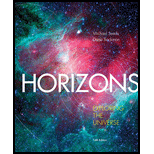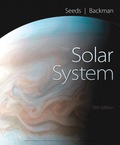
Horizons: Exploring the Universe (MindTap Course List)
14th Edition
ISBN: 9781305960961
Author: Michael A. Seeds, Dana Backman
Publisher: Cengage Learning
expand_more
expand_more
format_list_bulleted
Textbook Question
Chapter 20, Problem 12RQ
Why is it reasonable to suspect that travel between stars is nearly impossible?
Expert Solution & Answer
Trending nowThis is a popular solution!

Students have asked these similar questions
Why do we think that nothing, other than light, can travel faster than the speed of light?
What is the distance in meters to our Sun that is 500 light-seconds away?
. Make a web search and explain in your own words a method to measure distances inuniverse.
Chapter 20 Solutions
Horizons: Exploring the Universe (MindTap Course List)
Ch. 20 - If life is based on information, what is that...Ch. 20 - How does the DNA molecule produce a copy of...Ch. 20 - What would happen to a life-form if the genetic...Ch. 20 - What would happen to a life-form if the...Ch. 20 - Give an example of natural selection acting on new...Ch. 20 - Prob. 6RQCh. 20 - Why do scientists generality think that liquid...Ch. 20 - Prob. 8RQCh. 20 - What is the significance of the Miller-Urey...Ch. 20 - Prob. 10RQ
Ch. 20 - Prob. 11RQCh. 20 - Why is it reasonable to suspect that travel...Ch. 20 - How does the stability of technological...Ch. 20 - Prob. 14RQCh. 20 - Prob. 15RQCh. 20 - Prob. 16RQCh. 20 - How Do We know? Why are scientists confident that...Ch. 20 - Do you expect that hypothetical alien recipients...Ch. 20 - Prob. 2DQCh. 20 - Prob. 3DQCh. 20 - A single human cell encloses about 1.5 m of DNA,...Ch. 20 - If you represent Earth’s history by a line 1 m...Ch. 20 - Prob. 3PCh. 20 - If a star must remain on the main sequence for at...Ch. 20 - Prob. 5PCh. 20 - Prob. 6PCh. 20 - Prob. 7PCh. 20 - Calculate the numb of communicative civilizations...Ch. 20 - The star cluster shown in the image in Figure UN...Ch. 20 - Prob. 2LTL
Additional Science Textbook Solutions
Find more solutions based on key concepts
60. The solar system is 25,000 light years from the center of our Milky Way galaxy. One light year is the dista...
Physics for Scientists and Engineers: A Strategic Approach with Modern Physics (4th Edition)
5.106 A 70-kg person rides in a 30-kg cart moving at 12 m/s at the top of a hill that is in the shape of an arc...
University Physics (14th Edition)
GO You testify as an expert witness in a case involving an accident in which car A slid into the rear of car B,...
Fundamentals of Physics Extended
Order of Magnitude Estimate. Mathematical Insight 1.3 defines order of magnitude estimates, and in the text we ...
The Cosmic Perspective (9th Edition)
Using the definitions in Eqs. 1.1 and 1.4, and appropriate diagrams, show that the dot product and cross produc...
Introduction to Electrodynamics
The refractive index of a human cornea is 1.40. If 550-nm light strikes a cornea at incidence angle 25, find (a...
Essential University Physics: Volume 2 (3rd Edition)
Knowledge Booster
Learn more about
Need a deep-dive on the concept behind this application? Look no further. Learn more about this topic, physics and related others by exploring similar questions and additional content below.Similar questions
- If you travel at one half the speed of light, How long does it take to reach a star which is 4 light years away? 2 years 4 years 8 years 16 years none of thesearrow_forwardChoose a unit distance in cm that would easily fit on a piece of paper. Let this be your scale distance, now divide your scale distance by 4.3 light years to get the scale that will allow you to convert between real distances and distances in your model. Scale = cm / 4.3 ly = cm / lyarrow_forwardLight from the Sun reaches us in nearly A. 2 minutes B. 4 minutes C. 8 minutes D. 16 minutesarrow_forward
- A star is 80 light years from Earth. How fast does a spacecraft have to be for the journey to last the 70 years of an astronaut's life? The answer is 0,7526c. Show a complete approach on how to get to the answer by using the necessary equations.arrow_forwardA woman living in galaxy X is about to deliver her first baby. The nearest hospital is in galaxy Y, which is 1.0 x 1012 m away. The woman flew to the hospital in her spaceship at 0.8c. She gave birth one hour after she started flying as timed by her. From the point of view of the nurses at the hospital: i) What was the elapsed time when the woman watch indicated one hour? ii) Howfar did she travel in that one hour? iii) Was the baby born in the hospital? Justify your answerarrow_forwardThe meter was redefined as a reference to Earth, then to krypton, and finally to the speed of light. Why do you think the reference point for a meter continued to change?arrow_forward
arrow_back_ios
arrow_forward_ios
Recommended textbooks for you
 Stars and Galaxies (MindTap Course List)PhysicsISBN:9781337399944Author:Michael A. SeedsPublisher:Cengage Learning
Stars and Galaxies (MindTap Course List)PhysicsISBN:9781337399944Author:Michael A. SeedsPublisher:Cengage Learning Foundations of Astronomy (MindTap Course List)PhysicsISBN:9781337399920Author:Michael A. Seeds, Dana BackmanPublisher:Cengage Learning
Foundations of Astronomy (MindTap Course List)PhysicsISBN:9781337399920Author:Michael A. Seeds, Dana BackmanPublisher:Cengage Learning
 AstronomyPhysicsISBN:9781938168284Author:Andrew Fraknoi; David Morrison; Sidney C. WolffPublisher:OpenStax
AstronomyPhysicsISBN:9781938168284Author:Andrew Fraknoi; David Morrison; Sidney C. WolffPublisher:OpenStax

Stars and Galaxies (MindTap Course List)
Physics
ISBN:9781337399944
Author:Michael A. Seeds
Publisher:Cengage Learning

Foundations of Astronomy (MindTap Course List)
Physics
ISBN:9781337399920
Author:Michael A. Seeds, Dana Backman
Publisher:Cengage Learning


Astronomy
Physics
ISBN:9781938168284
Author:Andrew Fraknoi; David Morrison; Sidney C. Wolff
Publisher:OpenStax
Time Dilation - Einstein's Theory Of Relativity Explained!; Author: Science ABC;https://www.youtube.com/watch?v=yuD34tEpRFw;License: Standard YouTube License, CC-BY